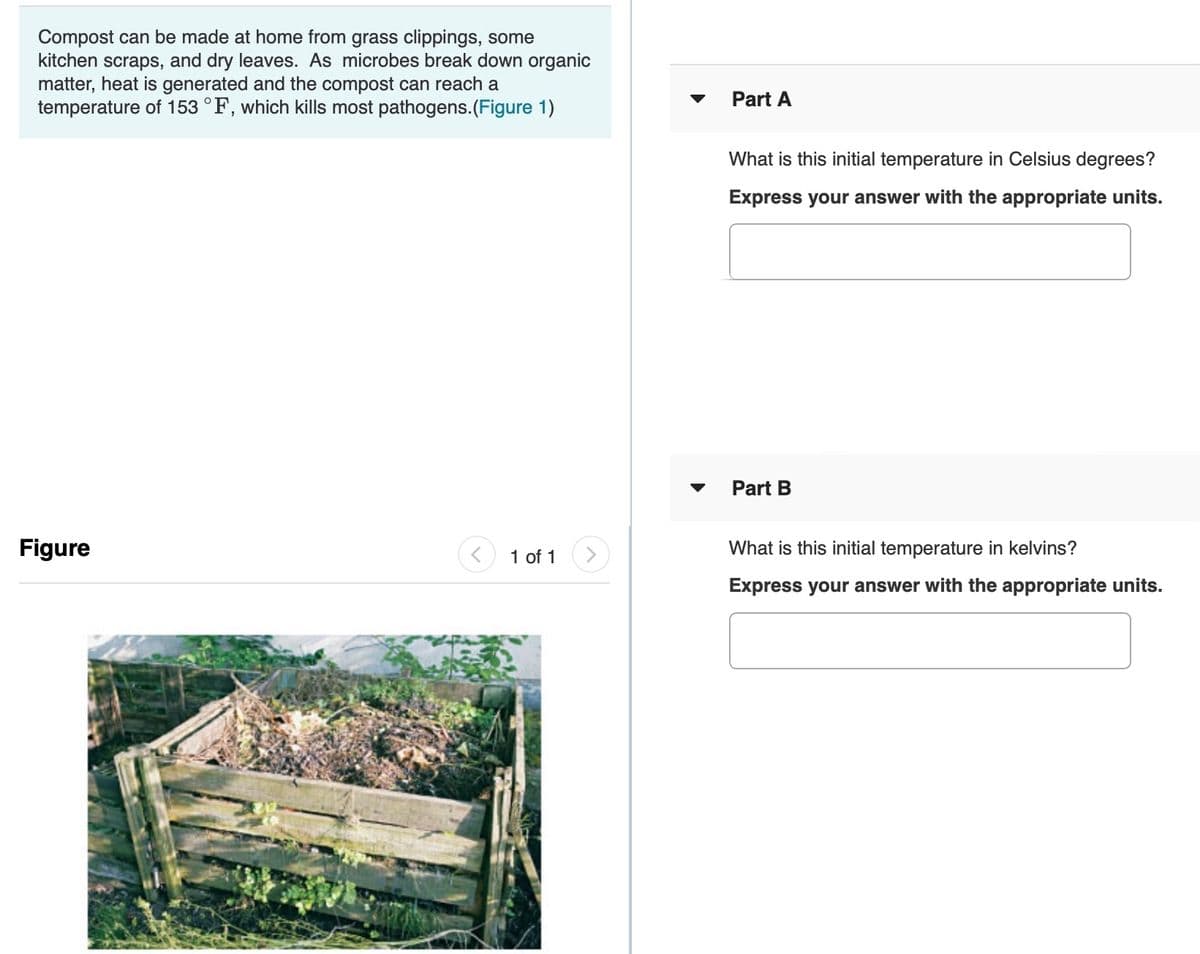Compost can be made at home from grass clippings, some kitchen scraps, and dry leaves. As microbes break down organic matter, heat is generated and the compost can reach a temperature of 153 °F, which kills most pathogens.(Figure 1) Part A What is this initial temperature in Celsius degrees? Express your answer with the appropriate units. Part B Figure 1 of 1 What is this initial temperature in kelvins? Express your answer with the appropriate units.
Compost can be made at home from grass clippings, some kitchen scraps, and dry leaves. As microbes break down organic matter, heat is generated and the compost can reach a temperature of 153 °F, which kills most pathogens.(Figure 1) Part A What is this initial temperature in Celsius degrees? Express your answer with the appropriate units. Part B Figure 1 of 1 What is this initial temperature in kelvins? Express your answer with the appropriate units.
Introduction to General, Organic and Biochemistry
11th Edition
ISBN:9781285869759
Author:Frederick A. Bettelheim, William H. Brown, Mary K. Campbell, Shawn O. Farrell, Omar Torres
Publisher:Frederick A. Bettelheim, William H. Brown, Mary K. Campbell, Shawn O. Farrell, Omar Torres
Chapter1: Matter, Energy, And Measurement
Section: Chapter Questions
Problem 1.86P: 1-86 The specific heats of some elements at 25oC are as follows: aluminum = 0.215 cal/g · oC; carbon...
Related questions
Question
100%
I need help on these two

Transcribed Image Text:Compost can be made at home from grass clippings, some
kitchen scraps, and dry leaves. As microbes break down organic
matter, heat is generated and the compost can reach a
temperature of 153 °F, which kills most pathogens.(Figure 1)
Part A
What is this initial temperature in Celsius degrees?
Express your answer with the appropriate units.
Part B
Figure
1 of 1
What is this initial temperature in kelvins?
Express your answer with the appropriate units.
Expert Solution
This question has been solved!
Explore an expertly crafted, step-by-step solution for a thorough understanding of key concepts.
This is a popular solution!
Trending now
This is a popular solution!
Step by step
Solved in 2 steps with 2 images

Knowledge Booster
Learn more about
Need a deep-dive on the concept behind this application? Look no further. Learn more about this topic, chemistry and related others by exploring similar questions and additional content below.Recommended textbooks for you

Introduction to General, Organic and Biochemistry
Chemistry
ISBN:
9781285869759
Author:
Frederick A. Bettelheim, William H. Brown, Mary K. Campbell, Shawn O. Farrell, Omar Torres
Publisher:
Cengage Learning

World of Chemistry, 3rd edition
Chemistry
ISBN:
9781133109655
Author:
Steven S. Zumdahl, Susan L. Zumdahl, Donald J. DeCoste
Publisher:
Brooks / Cole / Cengage Learning

Chemistry: Principles and Reactions
Chemistry
ISBN:
9781305079373
Author:
William L. Masterton, Cecile N. Hurley
Publisher:
Cengage Learning

Introduction to General, Organic and Biochemistry
Chemistry
ISBN:
9781285869759
Author:
Frederick A. Bettelheim, William H. Brown, Mary K. Campbell, Shawn O. Farrell, Omar Torres
Publisher:
Cengage Learning

World of Chemistry, 3rd edition
Chemistry
ISBN:
9781133109655
Author:
Steven S. Zumdahl, Susan L. Zumdahl, Donald J. DeCoste
Publisher:
Brooks / Cole / Cengage Learning

Chemistry: Principles and Reactions
Chemistry
ISBN:
9781305079373
Author:
William L. Masterton, Cecile N. Hurley
Publisher:
Cengage Learning

Chemistry & Chemical Reactivity
Chemistry
ISBN:
9781337399074
Author:
John C. Kotz, Paul M. Treichel, John Townsend, David Treichel
Publisher:
Cengage Learning

Chemistry by OpenStax (2015-05-04)
Chemistry
ISBN:
9781938168390
Author:
Klaus Theopold, Richard H Langley, Paul Flowers, William R. Robinson, Mark Blaser
Publisher:
OpenStax

Introductory Chemistry: An Active Learning Approa…
Chemistry
ISBN:
9781305079250
Author:
Mark S. Cracolice, Ed Peters
Publisher:
Cengage Learning